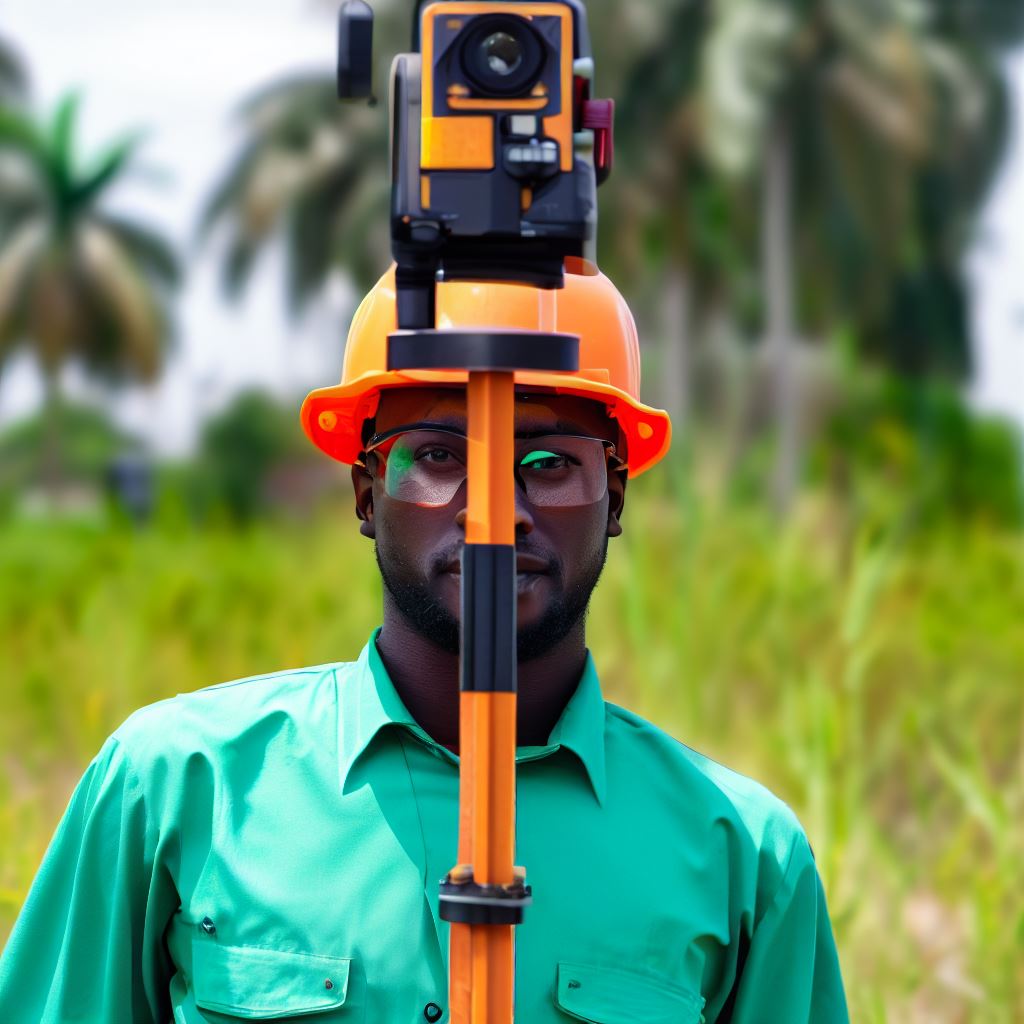Introduction
Surveying is an essential discipline used in various sectors such as construction, engineering, and land management in Nigeria.
It involves measuring, mapping, and documenting the physical characteristics of the land.
Technology plays a crucial role in enhancing the accuracy, efficiency, and productivity of surveying in Nigeria. It has revolutionized traditional surveying methods by introducing advanced tools and techniques.
Technology has significantly influenced surveying practices in Nigeria today.
The integration of modern equipment and software has improved data collection, analysis, and presentation, leading to more reliable and precise surveying results.
Technology has transformed surveying in Nigeria, enabling professionals to streamline processes and achieve better outcomes.
Historical Perspective of Surveying in Nigeria
A. Traditional surveying methods
- Surveying in Nigeria has a long history, dating back to ancient times.
- Traditional surveying methods involved the use of basic tools such as ropes, chains, and compasses.
- Surveyors relied on their knowledge and skills to measure land boundaries and create maps.
- These methods were time-consuming and often prone to errors.
- Surveying was primarily conducted by indigenous communities for land administration and resource management.
B. Limitations and challenges faced by surveyors
- Traditional surveying methods had limitations in terms of accuracy and efficiency.
- Surveyors faced challenges such as rough terrains, dense vegetation, and difficult weather conditions.
- Boundary disputes and land conflicts were common due to the lack of precise measurements and documentation.
- The traditional methods also limited the scope of surveying to smaller areas.
C. Transition to modern surveying techniques
- The advent of modern technology revolutionized surveying practices in Nigeria.
- Introduction of electronic distance measurement (EDM) devices improved accuracy and efficiency.
- Global Positioning System (GPS) enabled surveyors to determine precise positioning and coordinates.
- Satellite imagery and aerial photogrammetry provided detailed topographic data for surveying.
- Computer-aided design (CAD) software made it easier to process and analyze survey data.
- Modern surveying techniques expanded the capabilities of surveyors to handle larger and more complex projects.
- These advancements have also enhanced the integration of surveying with other disciplines like engineering and architecture.
- Surveyors now have access to advanced tools and technologies that have improved the quality and reliability of their work.
- Remote sensing techniques, such as LiDAR, have further expanded the possibilities in surveying applications.
- The transition to modern surveying techniques has increased the demand for skilled professionals in the field.
In essence, the historical perspective of surveying in Nigeria reflects the gradual transition from traditional methods to modern surveying techniques.
Traditional methods had limitations in terms of accuracy and efficiency, leading to challenges for surveyors. The advent of technology has revolutionized surveying practices, improving accuracy and efficiency.
Modern tools and technologies have expanded the capabilities of surveyors, enabling them to handle larger and more complex projects.
The transition to modern surveying techniques has increased the demand for skilled professionals in the field, contributing to the overall development of surveying in Nigeria.
Read: Career Growth and Salary Expectations for Surveyors in Nigeria
Technological Advances in Surveying
A. Introduction of Global Positioning System (GPS)
The introduction of the Global Positioning System (GPS) has revolutionized surveying in Nigeria.
GPS technology allows surveyors to accurately determine the coordinates of specific points on the earth’s surface using satellite signals. This technology has numerous benefits and applications in surveying.
One of the main benefits of GPS in surveying is its high level of accuracy. With GPS, surveyors can achieve precise measurements, resulting in more reliable data for various engineering and mapping projects.
The ability to obtain accurate measurements is crucial for the success of land development, infrastructure construction, and resource management in Nigeria.
Furthermore, GPS has made surveying faster and more efficient. In the past, surveyors had to rely on traditional methods such as traversing and triangulation, which required time-consuming measurements and calculations.
With GPS, surveyors can complete their tasks in a fraction of the time, allowing for increased productivity and cost savings.
GPS technology is not only limited to land surveying; it has also found applications in hydrographic and marine surveying.
By using GPS-equipped boats or vessels, surveyors can accurately map coastlines, rivers, and other bodies of water.
This data is crucial for coastal zone management, maritime navigation, and environmental monitoring.
B. Use of Geographic Information Systems (GIS)
The use of Geographic Information Systems (GIS) has greatly enhanced the field of surveying in Nigeria.
GIS combines spatial data with attribute data, allowing surveyors to store, analyze, and visualize geographic information effectively.
One significant advantage of GIS in surveying is its ability to enhance data collection and analysis.
Surveyors can input survey data directly into GIS software, eliminating the need for manual data entry and reducing the risk of errors.
GIS software also provides powerful analytical tools, enabling surveyors to perform complex spatial analysis and generate valuable insights.
In addition to data analysis, GIS has improved mapping accuracy in surveying. By integrating GPS data with GIS software, surveyors can create highly accurate and detailed maps.
These maps serve as essential references for land management, urban planning, and infrastructure development.
Accurate mapping is particularly critical in Nigeria, where rapid urbanization and land disputes are common.
C. Integration of aerial drones in surveying
The integration of aerial drones in surveying has brought about significant advantages and applications in Nigeria.
Drones, equipped with high-resolution cameras and sensors, can capture aerial imagery and collect data more efficiently than traditional surveying methods.
One advantage of using drones in surveying is the ability to access hard-to-reach areas.
Drones can navigate difficult terrains, such as dense forests or steep slopes, that are inaccessible or hazardous for surveyors.
This makes it possible to survey areas that were previously challenging or impossible to access.
Furthermore, drones enable rapid data acquisition and processing. Instead of spending hours or days collecting data manually, surveyors can deploy drones to capture aerial images within a short period.
The collected data can then be processed using specialized software, providing accurate and up-to-date information for decision-making and planning.
The applications of drones in surveying are diverse.
They are extensively used for mapping and monitoring large-scale construction projects, assessing topography, conducting environmental surveys, and managing natural resources.
Drones have proven to be a game-changer in the surveying industry, improving efficiency and reducing costs.
D. The rise of laser scanning technology
The rise of laser scanning technology has revolutionized surveying practices in Nigeria, offering high-definition 3D mapping capabilities and streamlining surveying processes.
Laser scanning technology, also known as LiDAR (Light Detection and Ranging), allows surveyors to capture precise measurements of an object’s shape, size, and position.
By emitting laser pulses and measuring the time it takes for the pulses to bounce back, LiDAR can create highly detailed 3D models of the surveyed area.
One of the main advantages of laser scanning technology is its ability to capture high-definition 3D maps.
These maps provide an accurate representation of the surveyed environment, allowing for detailed analysis and visualization.
The detailed information obtained through laser scanning is invaluable in various industries, including architecture, urban planning, and cultural heritage preservation.
In addition to its mapping capabilities, laser scanning technology streamlines surveying processes.
Traditional surveying methods often require manual measurements and data collection, which can be time-consuming and prone to errors.
Laser scanners, on the other hand, can quickly capture millions of data points in a matter of seconds, significantly reducing surveying time and improving accuracy.
Overall, technological advances in surveying, such as the introduction of GPS, use of GIS, integration of aerial drones, and the rise of laser scanning technology, have had a profound impact on the surveying industry in Nigeria.
These advancements have improved data accuracy, increased surveying efficiency, and expanded the applications of surveying in various sectors.
As technology continues to evolve, surveying professionals in Nigeria can expect further enhancements in their field, resulting in more precise and efficient data collection and analysis.
Read: Nigeria’s Land Surveying: Standards, Ethics, and Practice
Impacts of Technological Advancements on Surveyors in Nigeria
A. Increased efficiency and accuracy in surveying operations
- Technological advancements have streamlined surveying operations, leading to increased efficiency.
- New tools and techniques have improved accuracy in measuring distances, angles, and elevations.
- Modern equipment like GPS and laser scanners have made data collection and analysis more precise.
- The use of drones in surveying has reduced manual effort and improved the quality of results.
- Overall, technology has revolutionized the surveying profession in Nigeria, enhancing its effectiveness.
B. Reduction in surveying time and costs
- Traditional surveying methods were time-consuming and costly.
- With the introduction of technology, surveyors can now complete tasks in shorter periods.
- Automated data collection and analysis have greatly reduced manual labor, saving both time and money.
- Advanced surveying tools allow for quicker measurements and processing of data.
- As a result, clients can benefit from cost-effective surveying services in Nigeria today.
C. Enhanced data visualization and analysis for better decision-making
- Technology has enabled surveyors to present data in a more visual and understandable manner.
- Advanced software allows for the creation of detailed maps, 3D models, and interactive graphics.
- Surveyors can analyze data more effectively, identifying patterns and trends for better decision-making.
- Data visualization tools help stakeholders visualize survey results, aiding in project planning and development.
- Overall, technology enhances the clarity and accessibility of surveying data, benefiting various industries.
D. Empowerment of surveyors with advanced tools and techniques
- Surveyors in Nigeria are now equipped with cutting-edge tools and techniques.
- GPS technology provides accurate positioning and navigation, ensuring precise measurements.
- Laser scanners enable rapid data collection and detailed 3D mapping.
- Advancements in GIS software enable efficient data management, analysis, and integration.
- These tools empower surveyors, allowing them to deliver higher quality and more comprehensive services.
E. Challenges faced by surveyors in adopting and adapting to technology
- Despite the benefits, some surveyors in Nigeria face challenges in adopting and adapting to technology.
- Initial investment in modern equipment and software can be costly for small-scale surveyors.
- Training and adapting to new tools and techniques may require time and additional resources.
- Reliable access to electricity and internet connectivity is crucial for utilizing technology effectively.
- Educational institutions and industry associations need to provide continuous support and training for surveyors.
In review, technology has had a profound impact on surveying in Nigeria today.
Surveyors now benefit from increased efficiency, reduced time and costs, enhanced data visualization and analysis, as well as advanced tools and techniques.
However, challenges exist in adopting and adapting to technology, highlighting the need for support and training.
Overall, technology has transformed the surveying profession, making it more effective and relevant in modern Nigeria.
Read: Women in Surveying: A Look at the Profession in Nigeria

Learn More: Decoding Real Estate Financing in Nigeria
Case Studies: Technology Applications in Nigerian Surveying
A. Improved land administration through digital mapping systems
- Land administration in Nigeria has greatly improved due to the implementation of digital mapping systems.
- These systems allow for accurate and efficient mapping, recording, and management of land parcels.
- Property owners can easily access information about their land, reducing disputes and conflicts.
- The use of digital mapping systems has also facilitated land registration processes and reduced bureaucratic bottlenecks.
B. Smart city development and urban planning using GIS
- The application of Geographic Information System (GIS) technology has revolutionized urban planning in Nigeria.
- GIS enables city planners to analyze and visualize spatial data, leading to informed decision-making.
- By integrating data from various sources, GIS helps in identifying areas for infrastructure development and optimal resource allocation.
- Smart city initiatives, such as intelligent traffic management and efficient waste management, have been made possible with GIS.
C. Infrastructure development and monitoring with drones and GPS
- Drones and GPS technology have transformed the way infrastructure projects are developed and monitored in Nigeria.
- They provide accurate and real-time data for surveying, mapping, and monitoring construction sites.
- Drones can capture high-resolution images and create 3D models, enabling better visualization and analysis of project progress.
- GPS technology allows for precise positioning and navigation, improving efficiency and reducing errors in infrastructure development.
D. Precision farming and agricultural land mapping with GPS and remote sensing technology
- GPS and remote sensing technology have revolutionized precision farming and agricultural land mapping in Nigeria.
- They enable farmers to precisely monitor and manage their land, leading to improved productivity and reduced resource wastage.
- GPS provides accurate location data, allowing farmers to efficiently plan irrigation, fertilization, and pest control activities.
- Remote sensing technology, such as satellite imagery, helps in monitoring crop health, identifying disease outbreaks, and optimizing yields.
These case studies demonstrate the significant impact of technology on surveying in Nigeria today. Digital mapping systems have improved land administration and reduced disputes.
GIS technology has facilitated smart city development and urban planning. Drones and GPS have transformed infrastructure development and monitoring.
GPS and remote sensing technology have revolutionized precision farming and agricultural land mapping.
The adoption of these technologies has not only increased efficiency and accuracy but also opened new opportunities for sustainable development and economic growth in Nigeria.
Read: The Impact of Technology on Surveying in Nigeria Today
Future Trends and the Potential of Technology in Nigerian Surveying
A. Embracing artificial intelligence and machine learning algorithms
- Nigerian surveyors can incorporate AI and machine learning to automate data analysis and interpretation.
- These technologies can handle large volumes of data and generate accurate insights.
- AI algorithms can identify trends and anomalies in survey data, improving efficiency and accuracy.
- Machine learning can enhance the speed and precision of land mapping and boundary delineation.
- The adoption of AI and machine learning will require surveyors to update their skills and knowledge.
B. Exploring the possibilities of virtual reality and augmented reality
- Virtual reality (VR) and augmented reality (AR) can revolutionize surveying practices in Nigeria.
- VR can provide immersive experiences, allowing surveyors to visualize and analyze survey data in real-time.
- AR can overlay digital information onto the physical environment, aiding in field surveys and data collection.
- These technologies can enhance collaboration among surveyors and stakeholders in decision-making processes.
- The potential of VR and AR in Nigeria’s surveying sector is vast and should be explored.
C. Integration of blockchain technology for secure and transparent land records
- Blockchain technology can ensure the security and transparency of land records in Nigeria.
- By using decentralized and immutable ledgers, land transactions can be recorded in a tamper-proof manner.
- Smart contracts on the blockchain can automate processes and reduce the potential for fraud and corruption.
- Surveyors can verify land ownership and boundaries using blockchain-based systems.
- The integration of blockchain technology can enhance trust and efficiency in Nigeria’s land administration.
D. Importance of continuous professional development for surveyors in a technology-driven industry
- As technology advances, surveyors in Nigeria must actively engage in continuous professional development (CPD).
- CPD programs can equip surveyors with the necessary skills and knowledge to adapt to technological advancements.
- Continuous learning will help surveyors stay updated on the latest tools and techniques in the industry.
- CPD can foster innovation and ensure that surveyors are well-equipped to meet the demands of a technology-driven industry.
- Nigerian surveyors should prioritize CPD to remain competitive and deliver high-quality services in a rapidly evolving field.
Read: How to Become a Licensed Real Estate Agent in Nigeria
Conclusion
A recap of the impact of technology on surveying in Nigeria today is necessary to highlight the significant changes technology has brought to the field.
Surveyors in Nigeria have experienced both challenges and opportunities in embracing technology in their practices, which should be acknowledged.
It is highly encouraged for surveyors to further explore and utilize technology in their surveying practices to continue improving efficiency and accuracy.




